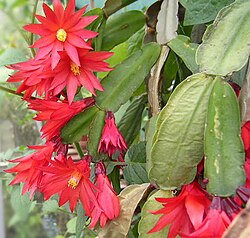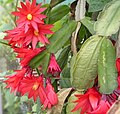| Rhipsalidopsis | |
|---|---|
 | |
| Rhipsalidopsis gaertneri in cultivation | |
| Scientific classification | |
| Kingdom: | Plantae |
| Clade: | Tracheophytes |
| Clade: | Angiosperms |
| Clade: | Eudicots |
| Order: | Caryophyllales |
| Family: | Cactaceae |
| Subfamily: | Cactoideae |
| Tribe: | Rhipsalideae |
| Genus: | Rhipsalidopsis Britton & Rose [1] |
| Species | |
Rhipsalidopsis is a small genus of flowering plant in the family Cactaceae, native to southern Brazil. [2] Like other members of the tribe Rhipsalideae, its species are epiphytes, growing on trees.


